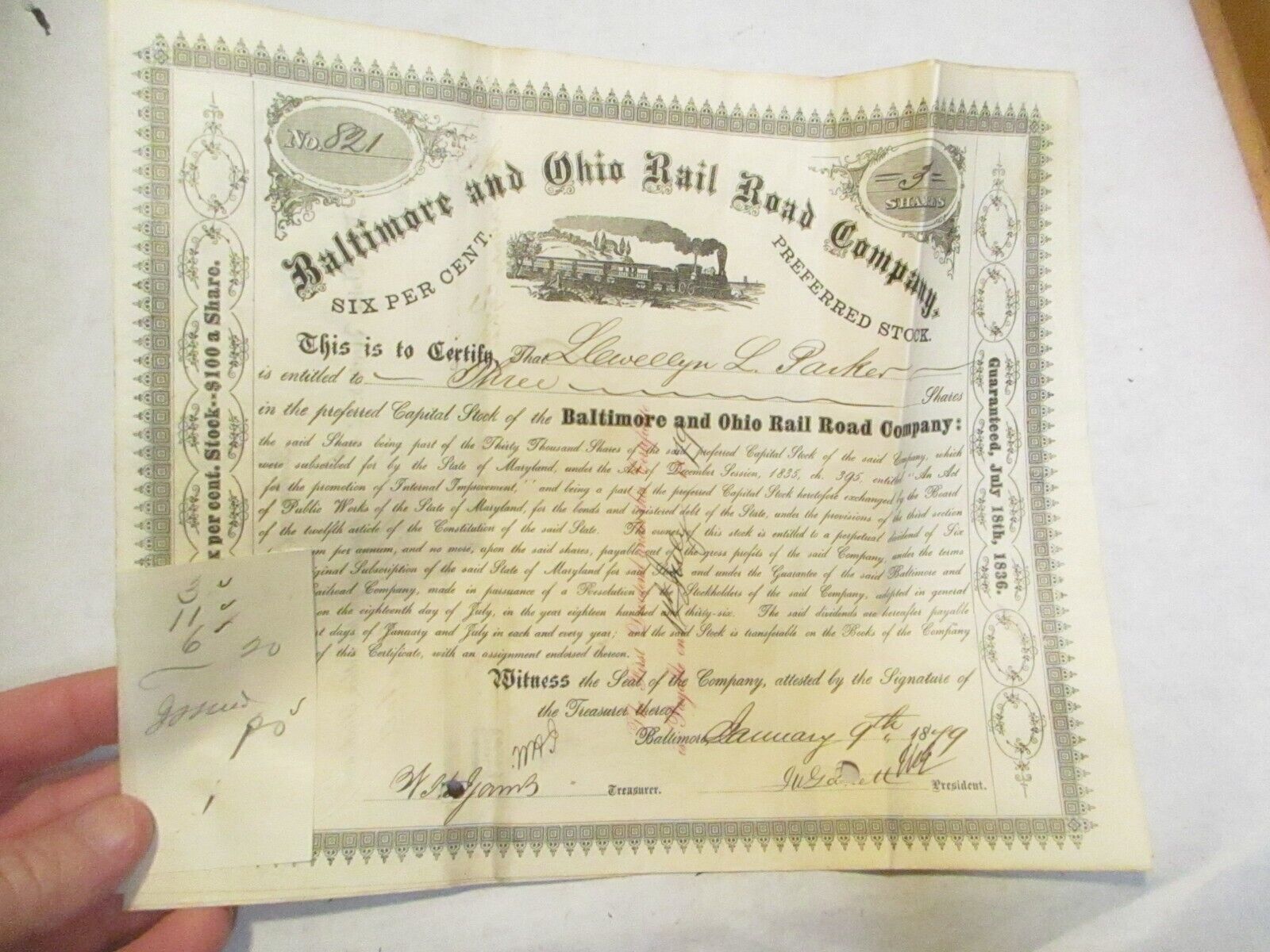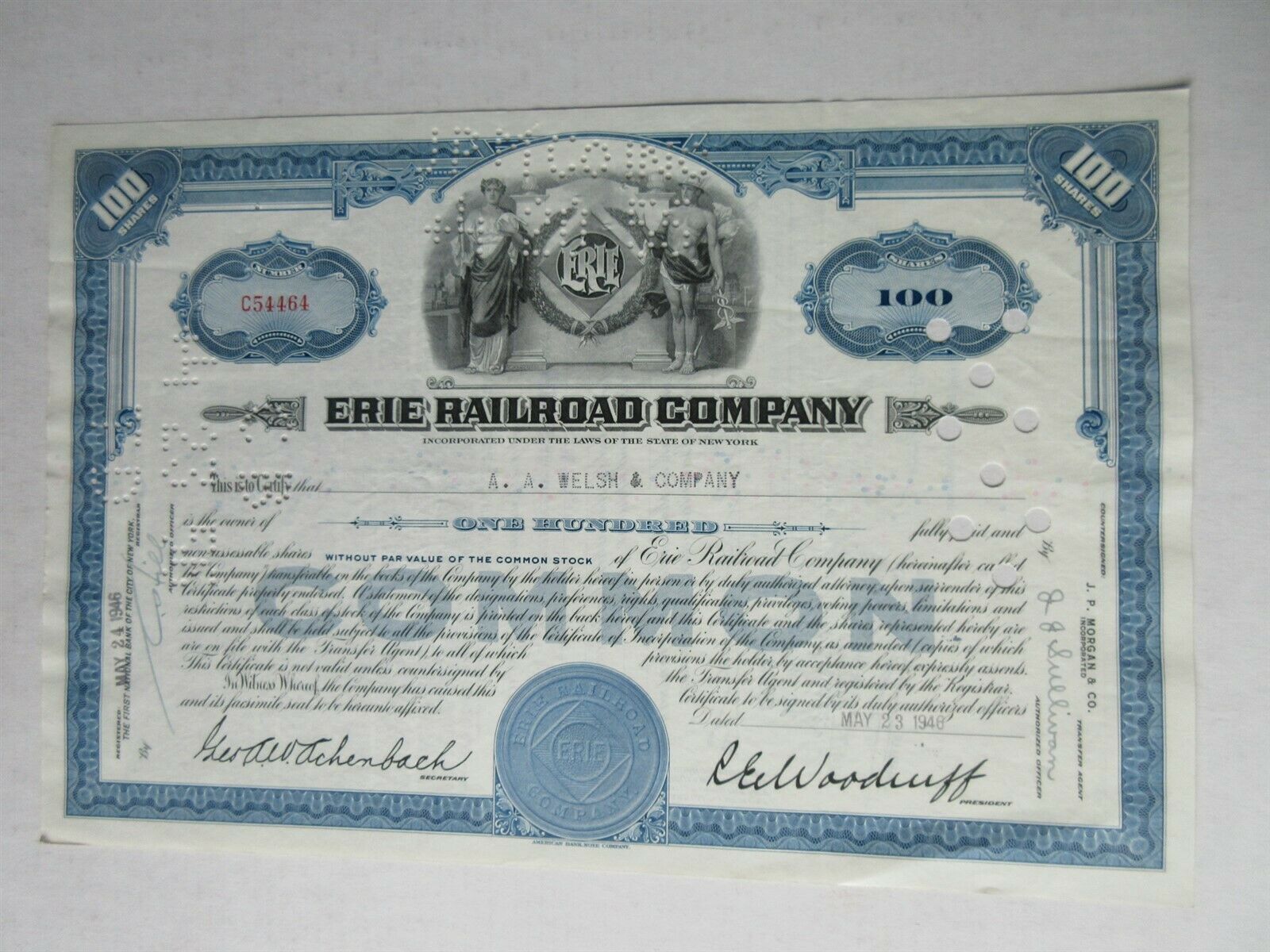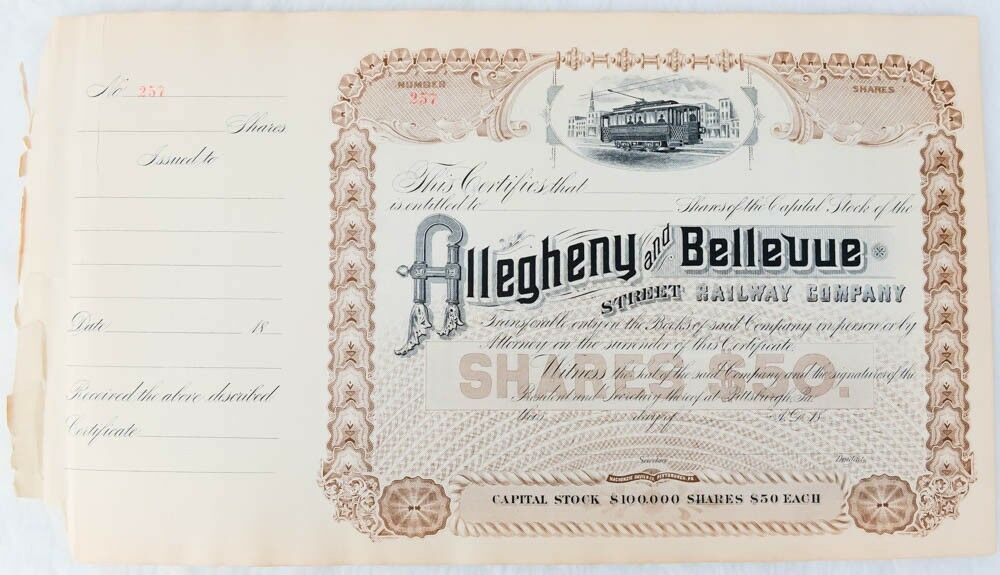-40%
1863 B&O Railroad Stock Certificate issued to Maryland. Fire Ins.Co..
$ 12.93
- Description
- Size Guide
Description
The Baltimore & Ohio Railroad CompanyBeautifully printed
Civil War Era Baltimore and Ohi
o Railroad Stock Certificate
No
.
31129
issued to
The President and Directors of Maryland Fire Insurance Company
for
50
shares on
September 28, 1863.
Stock Certificate
is hand signed by
John Work Garrett
President of B&O and a friend and confidante of President
Abraham Lincoln
during the Civil War. Garrett originally from Virginia sympathized with the south but became disillusioned when the Confederates continually destroyed his railroad. Siding with the Union thereafter B&O transported troops and supplies, a great benefit for the Union during the Civil War.
Garrett accompanied Lincoln as his friend and confidante to battlefields in Maryland and upon President Lincoln’s assassination organized the funeral train that carried his body back to his native Springfield, Illinois.
The certificate has a vignette of a wood burning locomotive pulling a freight train flanked by vignettes of lovely ladies. Certificate has two round blue cancellation stamps indicating cancellation on November 21, 1863 in addition to
an embossed B&O corporate seal.
Officer’s signatures are punch canceled but otherwise, the certificate is in very fine condition.
Detailed Civil War significance of the B&O Railroad
follows :
Baltimore & Ohio Railroad Service in the Civil War
Cannons, generals and soldiers were unquestionably critical components of the Union war effort, but another piece of the puzzle was the Yankees' ability to use railroads to quickly move everything from hardtack to siege artillery to points where they were needed most. One iron highway in particular, the Baltimore & Ohio Railroad, helped determine the course of the war by allowing the North to shuttle men to and from the Western and Eastern theaters and by bringing foodstuffs grown in the Midwest to Federal armies in the East.
By 1861, the B&O stretched from Baltimore in the east to Wheeling, Va., and the Ohio River in the west. The B&O owned more than 75 locomotives, 2,000 freight cars and in excess of 100 passenger cars. Company coffers bulged with more than million in assets.
At the beginning of the Civil War, the North and South each claimed the railroad. The B&O presented two equally important problems to the Union and the Confederacy. Confederate President Jefferson Davis and the Confederacy needed to maintain possession of the rail line's tracks in northwestern Virginia in order to prevent the capture of strategically important Harpers Ferry. Meanwhile, the North was anxious to keep the Confederates from commanding a single mile of track on the most important northern railroad extending west of the Appalachian Mountains.
Baltimore & Ohio President John Garrett, a Virginian by birth, made no secret of his affinity for the South and often referred to Confederate leaders as his 'Southern friends.' When Union Maj. Gen. Benjamin Butler arrested Confederate supporters during his occupation of Baltimore in the first days of the war, executives who used the B&O to transport goods realized their commercial and financial ties lay with the North. Additionally, Baltimore's north-central location physically precluded the B&O from supporting the Confederacy.
So
when President Abraham Lincoln and the Northern states called, John Garrett answered with his full support. The B&O stayed with the Union.
Despite that decision, the B&O came under suspicion from both the United States and the Confederacy. In April 1861, Garrett received an anonymous letter containing threats that pro-Confederate forces promised to destroy tracks, burn bridges and demolish company buildings if the B&O continued to transport Union soldiers. Within a week, Garrett read an editorial in the pro-Union Wheeling Intelligencer criticizing the railroad's willingness to transport Confederate soldiers from western Maryland and Virginia. Later in the summer, Secretary of War Simon Cameron warned Garrett that transporting Southern soldiers constituted a treasonous act. During the entire war, John Garrett's B&O came under continual attack in both Northern and Southern editorial columns.
On April 19, 1861, six days after Fort Sumter
surrendered,
Abraham Lincoln called for 75,000 volunteers.
When word spread across Baltimore that B&O officials had approved a plan to transport soldiers from the 6th Massachusetts Infantry through the city to Washington, D. C., pro-Southern sympathizers protested to Mayor George W. Brown and Governor Thomas H. Hicks.
Soon after, John Garrett received a note from the mayor of Charles Town, Va., stating that in the event the B&O transported the 6th Massachusetts over its main stem, Virginia militia forces stationed near Charles Town stood prepared to destroy the carrier's bridges at Harpers Ferry.
Garrett refused to back down from the threats and ordered company officers to ensure the 6th Massachusetts kept its schedule and boarded B&O cars bound for the short trip to Washington. After disembarking from cars belonging to the Philadelphia, Wilmington & Baltimore Railroad, the 6th Massachusetts moved toward the B&O's main terminus located at Camden Yards. A rock-throwing, pro-Southern mob followed the soldiers. Outside the main station, shots rang out and by the time the firing ceased, nine civilians and four soldiers lay dead, with dozens more wounded or injured.
After fighting its way through the crowd, the 6th Massachusetts finally boarded B&O cars and made their way to Washington. To prevent further outbreaks of violence, Garrett and Mayor Brown suspended rail operations in and around Baltimore for three days. For several weeks after April 19, Union troops could only reach Washington by Chesapeake Bay steamers and the railhead at Annapolis.
In April 1861, Confederate forces under 'Stonewall' Jackson occupied Harpers Ferry, at the mouth of the Shenandoah River in western Virginia. Under orders from Virginia Governor John Letcher, Jackson was forced to allow B&O trains carrying coal.
Jackson found the arrangement insufferable because he knew the coal passing through his sector fueled Northern factories and industries. He convinced the B&O president to restrict the carrier's traffic to regularly scheduled passenger and express trains that ran only during daylight hours. 'The noise of your trains is intolerable,' Jackson complained. 'My men find their repose disturbed by them every night. You will have to work out some other method of operating them.'
Garrett realized that he was at Jackson's mercy, as the B&O line in and around Harpers Ferry was subject to destruction. Garrett also reasoned that since Jackson had neither captured nor destroyed B&O property in Harpers Ferry, then perhaps the
general would continue to allow the B&O to pass through the region unmolested. Garrett therefore complied with Jackson's request and ordered B&O engineers to restrict rail operations in the Harpers Ferry region to daylight hours only.
Several days later, Jackson sent Garrett yet another letter: Could the B&O further limit its daytime traffic through the Harpers Ferry area to a two-hour corridor in order to prevent interference with routine training conducted by Confederate troops? Garrett again complied, and the B&O began to funnel all traffic through Harpers Ferry only between 11 a.m. to 1 p.m.
On May 23, 1861, the same day Virginia seceded from the Union, Jackson sprang his trap on the B&O Railroad. While voters across Virginia went to the polls, Jackson ordered Captain John
Imboden
at Point of Rocks, Md., to allow all B&O westbound trains to proceed as they normally did until noon that day. Jackson further instructed
Imboden
to stop all eastbound traffic on the main stem. Beginning at midday,
Imboden
and his men destroyed enough B&O track to necessitate several days of repair. At the same time, Colonel Kenton Harper in Martinsburg was under orders to allow all eastbound traffic to pass without delay but to stop all trains traveling westbound and then destroy a sizable portion of track. Unable to travel east or west, more than 300 rail cars and 56 locomotives fell into Confederate hands. Several days later, Jackson ordered the equipment moved to Richmond, where the captured engines and cars became part of the Confederate rail service.
For the remainder of the summer, Jackson's regiments continued to harass and disrupt rail operations around Harpers Ferry. In June Jackson destroyed 42 engines and numerous shops in the Martinsburg yard of the B&O. By the end of August, Jackson had wreaked enough damage on the railroad to cause it to cease operations on its main stem for more than 10 months.
In contrast, the line's finest moment came in September 1863 when the B&O played a leading role in the longest Civil War-era deployment by rail of soldiers from one theater of operations to another. In early September, Confederate General Braxton Bragg defeated Maj. Gen. William Rosecrans at Chickamauga in northwest Georgia. Federal Secretary of War Edwin Stanton realized the loss at Chickamauga threatened the safety of the Union stronghold at Chattanooga, Tenn.
On September 24, Stanton convened a meeting at the War Department to discuss methods of moving the approximately 25,000 men of the XI and XII corps from Virginia to Chattanooga to reinforce Rosecrans. Stanton knew speed was essential, and the next morning orders went out from the War Department to move the men by rail. The reinforcements began their journey on cars powered by locomotives belonging to the Baltimore & Ohio Railroad. By the time the last of the 30 trains consisting of more than 700 cars reached Chattanooga, only eight days had elapsed since Garrett and Stanton worked out the details of the movement. The effort helped keep Chattanooga in Union hands for the remainder of the war.
Garrett personally assisted in foiling the last major Confederate drive north of the Potomac River. In the summer of 1864, Lt. Gen. Jubal Early led his Army of the Valley north through the Shenandoah Valley to Harpers Ferry. At his Baltimore
headquarters, Garrett began to receive reports that Rebels were along the B&O line in force. Union authorities ignored that information and remained convinced the movement was nothing more than a cavalry raid, and that all the sizable Confederate infantry forces were tied up around Petersburg. Garrett decided to see for himself, and headed west on his own special train. He quickly learned the Southern presence was real, and hurried back to Baltimore and the headquarters of Middle Department commander Maj. Gen. Lew Wallace to tell him the news.
Convinced, Wallace began to move troops to
Monocacy
Junction, a spur of the B&O just south of Frederick, Md., so he could be in a position to cover the approaches to both Baltimore and Washington. He also called for reinforcements from Petersburg. Grant sent those men, a division of the VI Corps, on boats up the Chesapeake Bay to Baltimore, where they hopped on B&O cars provided by Garrett that whisked them to
Monocacy
Junction.
The resulting Battle of
Monocacy
on July 21 was a Confederate victory, but it slowed down
Early
long enough to allow more Federal troops to arrive in Washington and prevent the Rebel raiders from investing the Union capital. Rebuffed, Early headed back into the Shenandoah. The Union's debt to Garrett and the B&O had grown, as the man and his railroad played had a large role in foiling a Confederate incursion that at the least could have been an embarrassment, and at the most could have changed the course of the war.
John Garrett's wily leadership, and his ability to separate his company's best interests from his personal preferences and side with the Union, allowed the B&O to remain a viable company through most of the war, despite the hardships visited upon the rail line. He continued in his role as the B&O Railroad's president until his death in 1884, and lived long enough to see the federal government support him in several railroad strikes. Garrett was always proud, and rightly so, of the time in his railroad's history when the belch of his locomotives meant as much to the Northern war effort as the blast of cannons.










